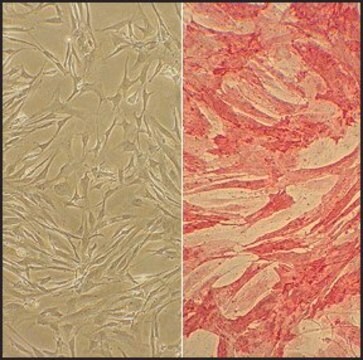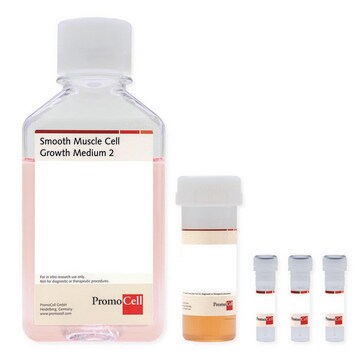350-05A
Human Coronary Artery Smooth Muscle Cells: HCASMC, adult
Sinonimo/i:
HCASMC cells
About This Item
Prodotti consigliati
Origine biologica
human coronary artery (normal, tunica intima and media)
Livello qualitativo
Confezionamento
pkg of 500,000 cells
Produttore/marchio commerciale
Cell Applications, Inc
Modalità di accrescimento
Adherent
Cariotipo
2n = 46
Morfologia
smooth muscle
tecniche
cell culture | mammalian: suitable
Malattie correlate
diabetes; stroke; cardiovascular diseases
Condizioni di spedizione
dry ice
Temperatura di conservazione
−196°C
Descrizione generale
Human Coronary Artery Smooth Muscle Cells (HCASMC) provide an excellent model system to study all aspects of cardiovascular function and disease, especially those related to mechanisms of hyperplasia and hypertrophy of intimal smooth muscle cells leading to vascular occlusion in atherosclerosis and stent restenosis.
HCASMC has been utilized in a number of research studies, for example, to:
- Study signaling pathways regulating smooth muscle differentiation (Zhou, 2010); and chronic inflammation of arterial wall that leads to artherosclerosis (Kiyan, 2014)
- Demonstrate that STAT-1 and STAT-3 regulate VEGF production in smooth muscle cells by having opposing effects on HIF-1α expression (Albasanz-Puig, 2012); study the mechanisms of hypoxia and reoxigenation injuries in by demonstrating increased production of ROS and inflammatory cytokines, and further showing that DHA is not beneficial in this type of injuries (Feng, 2012)
- Investigate the gene expression differences between smooth muscle cells from different arteries, underlying their differential response to injuries and proliferation stimuli (Lange, 2013)
- Suggest the hypermethylation of SOCS3 gene as the connection between TNF-α and IGF-1 released in response to mechanical injury during coronary intervention, and the induction of cytokines leading to intimal hyperplasia and restenosis (Dhar, 2013)
- Develop a novel VEGFR/MET-targeted inhibitor with improved antitumor efficacy and decreased toxicity (Fujita, 2013); and investigate novel therapies and drug combinations to achieve optimal target selectivity (Lehar, 2009; Wo-Wong, 2013)
- Develop elastic scaffolds for tissue engineering (Nivison-Smith, 2010, 2012) and novel treatment strategies to prevent stent restenosis by designing new materials (Crowder, 2012), or drug therapies to preferentially inhibit smooth muscle cell growth (O’Neill, 2009; Mociornita, 2013)
Characterization: positive for smooth muscle cell specific alpha-actin expression.
Origine della linea cellulare
Applicazioni
Componenti
Nota sulla preparazione
- 2nd passage, >500,000 cells in Basal Medium containing 10% FBS & 10% DMSO
- Can be cultured at least 16 doublings
Mantenimento delle subcolture
Esclusione di responsabilità
Codice della classe di stoccaggio
11 - Combustible Solids
Classe di pericolosità dell'acqua (WGK)
WGK 3
Punto d’infiammabilità (°F)
Not applicable
Punto d’infiammabilità (°C)
Not applicable
Scegli una delle versioni più recenti:
Certificati d'analisi (COA)
It looks like we've run into a problem, but you can still download Certificates of Analysis from our Documenti section.
Se ti serve aiuto, non esitare a contattarci Servizio Clienti
Possiedi già questo prodotto?
I documenti relativi ai prodotti acquistati recentemente sono disponibili nell’Archivio dei documenti.
I clienti hanno visto anche
Articoli
Technical information for working with human coronary artery smooth muscle cells including thawing, subculturing and cryopreservation
Il team dei nostri ricercatori vanta grande esperienza in tutte le aree della ricerca quali Life Science, scienza dei materiali, sintesi chimica, cromatografia, discipline analitiche, ecc..
Contatta l'Assistenza Tecnica.





